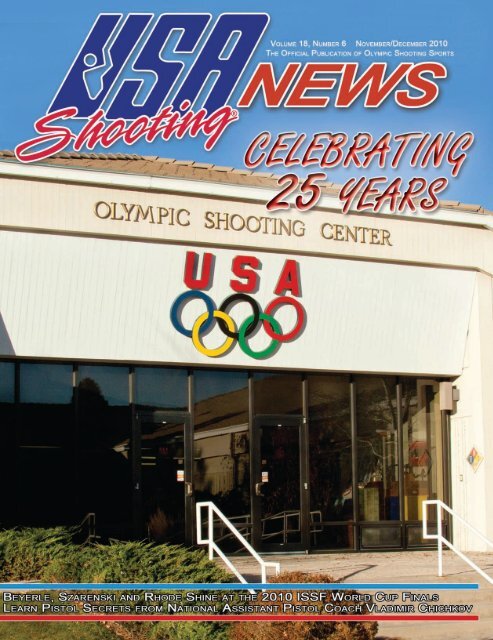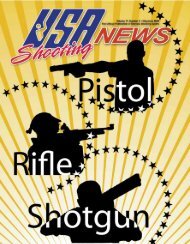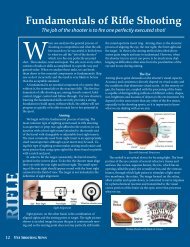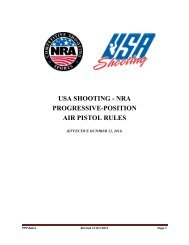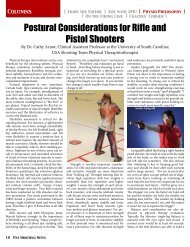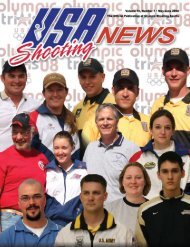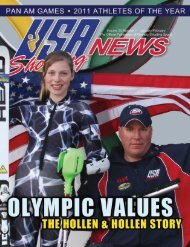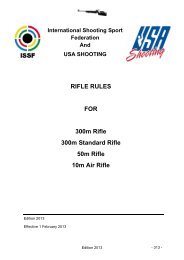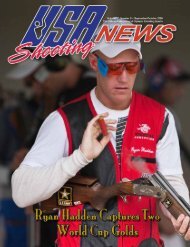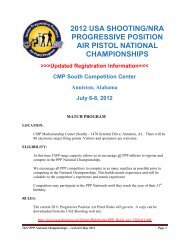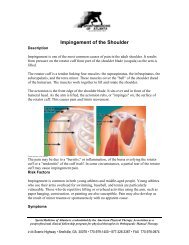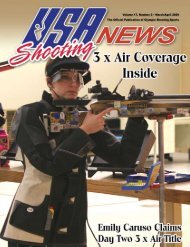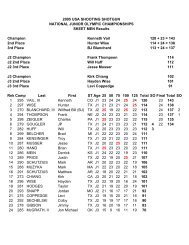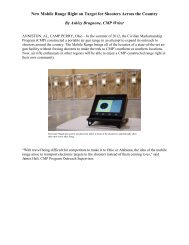November/December 2010: Volume 18, Number 6 - USA Shooting
November/December 2010: Volume 18, Number 6 - USA Shooting
November/December 2010: Volume 18, Number 6 - USA Shooting
- No tags were found...
Create successful ePaper yourself
Turn your PDF publications into a flip-book with our unique Google optimized e-Paper software.
Nov-Dec Issue <strong>2010</strong>.indd 311/8/10 9:22 PM
From the Executive DirectorVALUABLE VOLUNTEERSVolunteers are the key to the success of all non-profit organizations and <strong>USA</strong> <strong>Shooting</strong>(<strong>USA</strong>S) is no exception. We rely on volunteer coaches and competition staff atour member clubs, as well as at the national level. Serving as a coach or competitiondirector can certainly be challenging and time consuming, but it is also gratifyingto watch the progress of young athletes, as well as taking pride in conductinga well-managed event.The <strong>USA</strong>S staff members appreciate the quality work of our volunteers who have demonstrated apositive impact on our sport. As a result of their hard work, developing athletes are learning propertechniques and mental skills at an earlier age. Shooters funneling into our athlete pipeline are ata much higher skill level than even five years ago. Our Preliminary Tryouts (PTOs) and JuniorOlympic qualifier matches are being conducted efficiently and professionally. It is no secret thatour volunteers who organize national level matches conduct competitions that exceed the quality ofmany international events.We are always in need of more coaches and competition staff. At the club level, it is common forone or two key people to manage programs. Having additional help makes the task of managing aclub program less burdensome on leaders and creates a more enjoyable experience for all parties.<strong>USA</strong>S and the National Rifle Association (NRA) offer excellent coach education courses that helpprovide the training for new and developing coaches. Moreover, we are in the process of creatingand compiling information for potential and current volunteers to better illustrate common volunteerroles. There are numerous <strong>USA</strong>S volunteer tasks ranging from range officers to shotgun refereesto results management to target maintenance and more. Naturally, some tasks require more trainingthan others, which our staff and lead volunteers are most willing to provide. For those volunteersdesiring to officiate at national and world level events, we ask that referees and/or range officers worktoward becoming certified by <strong>USA</strong>S and/or the International <strong>Shooting</strong> Sport Federation (ISSF).In addition to the personal satisfaction derived from positively impacting all shooting events, ourvolunteers enjoy the camaraderie of socializing and developing long lasting relationships with othervolunteers and staff. If you have yet to experience serving as a volunteer, please give it a try, and ifyou are currently involved, please recruit more capable individuals. Volunteering is not only a gratifyingexperience but also a way to promote the shooting sports!■ Robert Mitchell<strong>USA</strong> <strong>Shooting</strong>1 Olympic PlazaColorado Springs, CO 80909Phone: 719-866-4670Administration Fax: 719-866-2200Competitions Fax: 719-866-4884Lindsay BrookeCompetitions Manager719-866-4885lindsay.brooke@usashooting.orgCalah DuryeaCoaches’ Assistant719-866-4883calah.duryea@usashooting.orgBuddy DuVallExecutive Director of <strong>USA</strong> <strong>Shooting</strong> Team Foundation719-866-4880buddy.duvall@usashooting.orgBret EricksonNational Shotgun Coach719-866-4682bret.erickson@usashooting.orgLisa EricksonOperation and Administrative Assistant719-866-4682lisa.erickson@usashooting.orgBob FothNational Paralympic Coach719-866-4881bob.foth@usashooting.orgDavid JohnsonNational Rifle Coach719-866-4630david.johnson@usashooting.orgNicole LevineCompetitions Assistant719-866-4882nicole.levine@usashooting.orgSergey LuzovNational Pistol Coach719-866-4615sergey.luzov@usashooting.orgKatie McGintyMedia & Public Relations Manager719-866-4896katie.mcginty@usashooting.orgRobert MitchellChief Executive Officer719-866-4899robert.mitchell@usashooting.orgNichole RaeMembership & Merchandise Manager719-866-4743nichole.rae@usashooting.orgBill RoyDirector of Operations719-866-4890bill.roy@usashooting.orgCorrie WestMarketing Manager719-866-4616corrie.west@usashooting.orgKarie WrightController719-866-4887Editor: Katie McGintyDesigner: Micki BensonPrinting: Sport GraphicsCover Photo: Katie McGinty<strong>USA</strong> <strong>Shooting</strong> News is published six times a year. <strong>USA</strong> <strong>Shooting</strong> is the national governing body for Olympic <strong>Shooting</strong> sportsin the United States. <strong>USA</strong> <strong>Shooting</strong> News is produced as a service to international shooters, coaches, officials and media whocover Olympic-style shooting. Shooters featured in <strong>USA</strong> <strong>Shooting</strong> News magazine may be photographed without eye protection.These are posed photographs using unloaded guns and do not represent actual competiton. <strong>USA</strong> <strong>Shooting</strong> encouragesall shooters to use proper eye and ear protection when shooting. Inclusion of advertisements in <strong>USA</strong> <strong>Shooting</strong> does notconstitiute endorsement of advertised products or services by <strong>USA</strong> <strong>Shooting</strong>, its staff or its sponsors.Contributors:SFC Terri DeWittEric PueppkeVladimir ChichkovRob LarsonMarcus RaabNicole LevineBob MitchellJP O’ConnorBill Roy4 <strong>USA</strong> <strong>Shooting</strong> NewsNov-Dec Issue <strong>2010</strong>.indd 411/8/10 9:22 PM
Columns (Aim with AMU)Random Rules You Should KnowWhether you are a20-year veteran or afirst-time rookie, itnever hurts to reviewthe rules of the game.As a matter of fact, as I was researching theInternational <strong>Shooting</strong> Sport Federation(ISSF) and the <strong>USA</strong> <strong>Shooting</strong> (<strong>USA</strong>S) rulebookfor this article, I learned a few things.For instance, years ago when I first joinedthe U.S. Army Shotgun Team under theleadership of coach Burl Branham, one ofthe unwritten, yet thoroughly understood,range rules was to never shoot a “tweetybird.”I had always thought that rule originatedwith Burl, but I’vediscovered that accordingto the <strong>USA</strong>S rulebook,“aiming or shooting atanother shooter’s targetsor deliberately aiming orshooting at live birds orother animals is prohibited(Sect. 9.2.3.2). I alsodiscovered that regulationsdiffered acrossthe disciplines. Being atrapshooter, I assumedthat the marker tapeon a skeet vest was tobe placed at the highestpoint of a skeet shooter’shipbone. While thismay coincidentally beundaries in skeet (Sect. 9.5.6.2).Additionally, while the referee must alwaysmake the final decision, if an assistant referee isin disagreement, it is his or her duty to advisethe referee by lifting an arm or otherwise attractingthe referee’s attention (Sect. 9.5.6.4).In other words, if the referee calls a lost target,but you (as the flanker) saw a piece come offthat target, you have an obligation to gain thereferee’s attention and advise him/her. So, ifyou are the shooter on the line, wouldn’t youappreciate a flanker who is paying attention?Moreover, the assistant referee’s duty is takenseriously enough by the ISSF and <strong>USA</strong>S that ashooter will be assessed a one target penalty forHave you read your rules and regulations lately? Copies of the ISSF Official Statues Rules andRegulations are available for purchase through <strong>USA</strong>S. You can download <strong>USA</strong> <strong>Shooting</strong>’s nationalregulations on the website.each absence or failure to provide a substitute(Sect. 9.5.6.3).Should you ever find yourself in disagreementwith a referee’s call, you may choose tofile a protest (Sect. 6.15). In <strong>USA</strong>S-sanctionedmatches, it will cost you $25.00 to file a protestand the jury’s decision will be final (there isno jury of appeals in the United States, so thecompetition jury’s decision is final [Sect. 2.6.5]).If the jury finds in your favor, your $25.00 willbe returned. In the event of a verbal protest,competition officials must consider the protestimmediately and take action to correct the situ-true, the word “hipbone”never actually appearsanywhere in the markertape placement rule(Sect. 9.6.14.12.3).An aspect of the game that deservesreview is the importance of the assistantreferees or “flankers.” The rulebook statesthat the referee must be assisted by two orthree assistant referees and that all shootersmust serve in this function when designated(experienced substitutes being acceptable).Some of the main duties of the assistantreferee include watching each targetthrown, signaling lost targets, maintainingan unobstructed view of the shooting areaand indicating targets hit outside of the boationor refer the matter to the jury (Sect.9.13.7.1.2). Any shooter or team officialwho does not agree with the action or decisiontaken on a verbal protest may make aformal protest in writing to the jury (Sect.9.13.7.2.1). Keep in mind that a writtenprotest may be submitted without firstmaking a verbal protest (Sect. 9.13.7.2.2).A protest begins when a shooter disagreeswith the referee’s decision regardinga particular target or recognizes a rulesviolation, for instance (Sect. 9.13.7.1.1).The shooter must act immediately beforethe next shooter fires by raising an arm andsaying “PROTEST” (Sect. 9.13.8.1). Thereferee must interruptthe shooting, discuss thesituation with the assistantreferees and makea decision. If the shooteris still in disagreement,he or she continues theround under protest, andthen files a written protest(with the appropriatefee) within 30 minutesafter the end of the roundin which the allegedincident occurred (Sect.9.13.7.2.3). If the shooterhas to flank, the protestmust be filed immediatelyafter the flankinground.Knowing andunderstanding the rulesthat apply to your sportfacilitates a cooperativespirit between competitors and officials. Butbecause the rules are not always written inunequivocal language, there is a caveat. It isthe duty of all competition officials to applythe rules fairly, faithfully and impartially.Yet in cases where ambiguity or doubtexists regarding a rule interpretation, thebenefit of doubt must go to the competitor(Sect. 2.6.1). Don’t forget to take a look atthe regulations and remember to stay Armystrong!■ SFC Terri DeWittwww.usashooting.org 5Nov-Dec Issue <strong>2010</strong>.indd 511/8/10 9:22 PM
Columns (On the Firing Line)Where Are You Looking?Fifty-second in a series10 th AnniversaryArticle“But I Must Have a Precise Reference!”Visual skills are very important in the target shootingsports. A great deal of time, money and effort areinvested in attempting to optimize the athlete’s visualenvironment. Special lenses, glasses and apertures orother devices are often put to use. In some cases visualtraining activities and routines are utilized. As with many aspectsof the sport, the visual fundamentals often become overlooked oncean athlete passes the learning stage and moves to the “advanced”aspects.Unlike shotgun athletes, target pistol shooters look at the frontsight. No, not at the target! While looking at the front sight is fairlyuniversally understood and accepted, there are subtleties that aregenerally overlooked. Where? Just as with the pistol shooter in theprevious article, we strive to look at the front sight, yet often end upwith our focus on the target and the front sight becomes blurry. Whyis this? There are at least two primary reasons:eye physiology and outcome concern.Our eyes, regardless of the use of correctivelenses, naturally focus at a great distancewhen relaxed. Bringing the plane of focus backfrom the distant target to the much closer frontsight requires muscular effort. We may see asharply focused front sight at first, only to see iteventually become less distinct and then fairlyblurred as our eye rapidly fatigues. This situationworsens as the match progresses as the eyemuscles fatigue, along with the rest of the mindand body.For most people, adjusting their normal lens correction by +0.50diopter sphere results in the front sight being so sharp that it almostseems to snap out of the picture. The eye is at rest and the front sightis crisp. For those who need no everyday eyewear correction, justwear a +0.50 diopter sphere lens.At this point, many people notice the target is no longer sharplydefined. See Figure 1 and notice the target is not crisp or deep black.(In practice, the target is not as grey as shown here, though it is stillvery indistinct.) Athletes either reject the lens or add an adjustableiris to their shooting glasses in an effort to re-sharpen the target.Although adjustable apertures are useful in some situations, this isnot one of those cases.It is a mistake to believe that the target must be sharp in order toshoot with precision. This has been proven by many, especially thosewho train on a special target with a black center that fades to whiteat the edge of the target card. There are no rings, center black orboundaries –just a continuous fade from black to white. Despite thelack of clear aiming reference, it is easier for most advanced athletesto shoot very tight groups on this training target than on a regulationtarget.Outcome concern is the other major reason our eye ends up out6 <strong>USA</strong> <strong>Shooting</strong> News“While looking at thefront sight is fairlyuniversally understoodand accepted, there aresubtleties that aregenerally overlooked.”on the target. After all, we are looking at what we think is our “goal.”The target is not the goal. It is a mental and visual distraction—especiallywhen worried about a poor shot. The target is only requiredfor an aiming reference and scoring. This principle applies universallyin all target shooting disciplines. Make sure to separate outcomefrom doing.We now turn our attention to the topic of where to look whenactually on aim. Though it seems obvious, pistol shooters often hear:“Look at the front sight!” Does that mean at the middle of the topedge, across the top edge or checking the white gaps on both sides?When on aim, the eye should rest quietly on the center of mass ofthe part of the front sight that is visible through the rear sight. Figure1 clearly shows a white dot on the spot where the eye must sit duringthe aiming process. When an athlete builds a solid physical and technicalroutine, he/she finds that when resting his/her eye on the whitedot he/she is able to perceive whether or notthe sights are aligned without “looking around”at the sight picture. With the eye resting in onespot, and the brain having less processing toperform, the hold area is dramatically reduced.Remember, active visual processing, or merelythinking, opens up the hold. Nothing raisesconfidence like steadiness!Having determined where to look withrespect to the front sight, now we must determinewhere to hold. Pistol shooters have a lotof choices: 1) center of the target, 2) bottomedge of the black, 3) very thin line of whitebetween the front sight and the edge of the black, 4) measured whitespace between the front sight and the bottom of the black that equalsthe white space on either side of the front sight, 5) deep down in thewhite and possibly others. All have their proponents and detractors.Center hold is very popular in standard pistol because of the mixof time limits for the 5 shot strings. It is essentially universal in therapid stages of sport/center and in the rapid fire pistol event due tothe design of the target. Some air and free shooters also choose thismethod.Bottom edge of the black hold and thin line of white hold are twocommon aiming techniques, especially for the precision events andstages. Many athletes dislike the black-white-black-white “flicker”above the front sight as their area of hold takes the sight above andbelow the bottom edge of the black. This aiming technique is distractingas it magnifies the perception of movement, thus reducingathlete confidence.Measured white hold reduces or eliminates the flicker problem(if the gap is large enough), while still providing an aiming referencethat feeds the perceived “need” of many shooters to have a “precise”aiming reference; however, measuring is a very active visual andcognitive process and is counterproductive.Nov-Dec Issue <strong>2010</strong>.indd 611/8/10 9:22 PM
Deep down in the white, interesting things happen. First, the athlete notices a lack ofdistinct aiming reference, which is frightening. Those who are willing to experiment, learnthat, if they let their eye rest on the front sight – yes, the white dot spot – the aiming areais “sensed” and the target is so far above the front sight that its move-ment is no longer adistraction. Note that the apparent movement is now the target’s because the eye is gentlyfollowing the front sight as if “locked on” and the perception of movement is diminished.Despite the target seeming to “float” well above the front sight, the brain is quite easilycapable of finding the same “spot” for shot release. Of course, the aiming “spot” must bethought of as an area of hold and accepted without reservation. This hold method is conduciveto deeper shot process techniques that result in shot delivery that is more consistent,confident and decisive.This technique is especially powerful in air and free events. Decreased distraction of thetarget movement and a “quiet eye” allow an athlete to instinctively know where to hold. Yes,this takes guts and time to develop, but it is a rewarding and powerful technique that resultsin small, confidently delivered groups. A quick “try” will give a false result and the techniquewill be prematurely and erroneously rejected. Now you know why the bull is so highabove the front sight in Figure 1.Figure 1Finally, we must explain why the gaps on either side of the front sight are so wide. Manypistol shooters, especially in the precision events of air and free, prefer very thin gaps and adjust their rear sight accordingly. Taken to an extreme,this is counterproductive, as will be seen in the discussion in the next article about rifle front aperture sizes. The same principles apply.This, and other related topics of interest to both rifle and pistol shooters, will be discussed in more detail in the next article.■ JP O’ConnorBased in the Atlanta, Ga., area, JP O’Connor (jpoc@acm.org and http://www.america.net/~jpoc/) is involved in shooting as a competitor, is a former Assistant NationalCoach – <strong>USA</strong> Paralympics <strong>Shooting</strong> Team, serves on the National Coach Development Staff in both rifle & pistol, coaches the rifle and pistol teams at NorthGeorgia College & State University, and coaches a junior club. He enjoys working with a number of pistol and rifle athletes from around the country, ranging frombeginners to the highly advanced, in clinics and one-on-one private coaching. Previous installments of this series may be found at www.pilkguns.com.ARE YOU A NATURALLYTALENTED SHOOTERWANTING TO IMPROVE?With hard workand professionalguidance I can helpyou reach yourpeak performance.Range located in Boise, IdahoFor more information on howI can help you improve, email:sillintercoach@yahoo.comIf you follow the instructions and don’timprove your score in two months,you will receive your money back!................................................Silvino Lyra is a 1999 <strong>USA</strong>/NRAInternational Advanced <strong>Shooting</strong>Coach who has coached gold andsilver medalists at thePan American Games and5 Olympians in the 2000 &2004 Olympic Games in the10m air pistol element ofModern Pentathlon........................................Coach’s PhilosophyThe soft overcomes the hard,the slow overcomes the fast,let your workings remain a mystery,just show people the results.-Lao TzuNov-Dec Issue <strong>2010</strong>.indd 711/8/10 9:22 PM
precision, consistentaiming and a controlledand quick armlift.One way to optimizethe position is bykeeping the feet almostparallel or at a smallangle (Figure 2). Thisslight inward twist,compared to the naturalpositioning of thefeet, will increase thestability of the ankles,knees and pelvis. Theexact degree of theangle should be determinedon an individualbasis in collaborationwith the coach.Even though neutralbalance is necessaryfor precision shooting,25m disciplines willfind more success byFigure 3bringing the weighta little in the direction to the toes (Figure 3). This will createa very slight imbalance that can be leveraged by both feet inthe direction of north to south. This will move the Center ofGravity (CG1) and the Projected Center of Gravity (PCG1) tonew positions (CG2 and PCG2.) Consequently, the tensionin the lower extremity (abdominal and back muscles) willincrease and augment the support of the arm and contributeto improved balance control. Forward bearing weight will alsohelp the body accommodate changes in position caused by liftand recoil. Too much imbalance is undesirable, since it willactivate more muscles and increase body tremor and fatigue.Many argue about the best orientation of the body in relationto the target. In my opinion, when shooting 25m disciplines,it is best to have the feet, the hand holding the gun andthe target in a straight line. It will be easier to compensate themovement of the Center of Gravity which will stay on thesame line while executing the hand lift for the rapid-fire stages.Another benefit of this orientation is that the main direction ofrecoil will align with the position, which will allow maximumleverage of the (north to south) supporting area and ensurebetter ability to keep the balance and recover from the recoil.Better control of the aiming position can be achieved by raisingthe shoulder to touch the cheek (Figure 4). If doable, thewhole extremity can serve as a rifle stock and add stabilitywhile providing an additional reference point for replicationof posture and aiming. In a “ready” position, when the arm islowered at 45 degrees, the shoulder does not necessarily touchthe cheek. Once the arm is raised to aim, everything comesback in place. Athletes who cannot bring the shoulder andcheek together should continue replicating their best positionuntil it becomes natural.We shoot at different ranges, levels of physical readinessand endurance during competitions. Therefore, we must finetune our posture and position. The goal is to keep the alignedsights in the aiming area with minimum effort. It is importantnot to change posture or adjust the aiming point by movingthe hand. Correction and verification of position will suffice.For any rapid fire series, it is important to check and adjustone’s position prior to each string. More details will come inour discussion regarding the hand lift. Left and right adjustmentscan be achieved by moving of the leg in second positionslightly to right or to the left for right-handed individuals, andvice versa for left-handed. Increasing the span between thefeet will raise the arm, while decreasing it will lower their position.For right-handed shooters, left and right adjustments ofthe aiming point can be achieved by moving of the left foot.Whereas moving it forward, the aiming point moves to theright; with moving backward, it goes to the left. Left-handedindividuals have to use the same principle by using the rightfoot. Increasing the span between the feet will raise the arm,while decreasing it will lower its position.I wish everyone straight shooting and good luck!■ Vladimir ChichkovpistolFigure 4www.usashooting.org 11Nov-Dec Issue <strong>2010</strong>.indd 1111/8/10 9:22 PM
Fundamentals of Rifle <strong>Shooting</strong>The job of the shooter is to fire one perfectly executed shot!rifleWhen one analyzes the general process ofshooting in competition and what the athletemust do to be successful, it boils downto what we call the “job of the shooter”which is to fire one perfectly executedshot. Then analyze, reset and repeat. The job, as in every other,consists of tasks or skills accomplished in a specific way andgeneral order. When we analyze these tasks, we can breakthem down to five essential components or fundamentals. Skipone or do it incorrectly and the result is very likely to be lessthan the acceptable standard.A fundamental is an essential component of a system that,without it, the system fails or the structure falls. The five fundamentalsof rifle shooting are: aiming, breath-control, holdcontrol,trigger-control and follow-through. For new shooters,learning the fundamental skills correctly provides a strongfoundation to build upon, without which, the athlete will notprogress as quickly or be able to reach his or her potential inthe sport.AimingWe begin with the fundamental process of aiming. Themost common type of sighting system used in rifle shootingis an aperture or peep rear sight affixed to the receiver, in conjunctionwith a front sight tunnel attached to the muzzle endof the barrel with changeable or adjustable front sight inserts.The most commonly used front-sight insert is an appropriatelysized round aperture although a post insert may be used. Usingthis type of sighting system makes aiming much easier andmore precise than using open sights like those found on pistolswith a notch and post.In order to hit the target consistently, the barrel must bepointed in the correct place. To do this the shooter must aligntheir eye with the rear sight and front sight. The small openingof the rear sight should appear round with the front sightcentered in the field of view. The target is not included in thedefinition of sight alignment.Sight AlignmentSight picture, on the other hand, is the combination ofaligned sights and the aiming point or target. The sight pictureshown is an ideal image because the gun is continuously movingand so the aiming point does not stay perfectly still insidethe round aperture insert ring. Aiming, then, is the dynamicprocess of aligning the eye, the rear sight, the front sight andthe target. In theory, the aiming method described aboveseems quite simple and easy to understand. However, whenthe shooter tries to aim it can prove to be much more challengingas difficulties often arise from the peculiarities of theeye and its use during aiming.The EyeAiming places great demands on the shooter’s visual capacity.Accuracy and consistency directly depend on visual acuity andthe conditions that determine visual acuity. As the sensory organ,the human eye, coupled with the processing of the brainis capable of distinguishing millions of different colors, shapes,size, brightness and location of objects in the environment. Wedepend on this sense more than any other of the five senses,especially in the shooting sports, so it is important to knowwhat we are dealing with as we aim.Eye with Internal StructuresThe eyeball is an optical device for focusing light. The frontportion of the eye consists of several refractory tissues andsurfaces, the cornea, aqueous humor, the iris, which has anopening called the pupil, the crystalline lens and the vitreoushumor, through which light passes to stimulate a light sensitivemembrane, the retina. The image formed on the retina,albeit smaller and upside down, is converted to nerve impulsesby a photochemical reaction and transmitted to the visualcortex portion of the brain via the optic nerve that processeswhat we see.Retina Detail with Rods & Cones12 <strong>USA</strong> <strong>Shooting</strong> NewsNov-Dec Issue <strong>2010</strong>.indd 1211/8/10 9:22 PM
In order to see the world around us clearly, the imageformed on the retina must be sharp. The normal eye at rest(or relaxed) is focused at infinity, so distant objects appear infocus, but nearby objects appear out of focus. To see closerobjects clearly, the ciliary muscle contracts reflexively tochange the shape of the crystalline lens to a more convex formincreasing the refractive power and bring the near object intofocus on the retina. This ability is called accommodation.Distant objects will now be out of focus. The eye cannot clearlyfocus on objects located at different distances at the same instant.While the reflex action of accommodation can take placequickly (especially in younger people when the crystalline lensis quite flexible) this puts a strain on the visual apparatus andmust be avoided.The eye also responds automatically to varying amounts ofambient light, by opening or closing the pupil via another reflexiveaction of the group of smooth muscles that controls theiris. This dilation or contraction of the pupil, called adaptation,regulates the amount of light entering the eye. The normalpupil opening ranges from a maximum of approximately eightmillimeters to a minimum of two or three millimeters. As weage, the maximum opening decreases to six millimeters makingit more difficult for older people to see at night. The pupilopening adapts much more quickly to increased illumination(a few seconds) than it does to a decrease in illumination(a few minutes). Therefore, it is critical to avoid looking atbrightly illuminated objects before or during shooting, and amajor reason flash photography is not permitted during shootingcompetitions.The action of the pupil is similar to the f-stop in a camera.The depth of field or the range of distances that the camera(eye) sees as being in focus increases as the f-stop aperture(pupil) size becomes smaller. The artificial pupil of the fixedrear aperture, or an adjustable rear iris, takes advantage of thisthereby allowing the shooter to increase the depth of field soall the elements of the sight picture are clearly seen in focus.Imperfections of the EyeAs a result of optical imperfections of the various componentsof the eye, the edges of the image produced on the retinaare not always perfectly clear. This is the ultimate limit of theresolution of the eye or visual acuity. However, under differingconditions of ambient light and/or fatigue, visual acuity is notconstant and can change.There are several inherent phenomena that occur as a resultof the eye being an optical instrument. The first is sphericalaberration, which occurs when parallel rays of light passingthrough the crystalline lens are refracted differently and thusnot focused at a single place on the retina. Light passing nearthe edge of the pupil, farther from the center of the opening,are refracted more than those passing through the center. Thisappears as a circle of diffused light rather than a sharp image.Spherical aberration is at a maximum when the pupil is openthe most. Image clarity can be improved if one can eliminatethe outer rays by either contracting the pupil or using an artificialpupil like that on the rear sight.Spherical AberrationA related problem is chromatic aberration. Visible lightis made of all the colors of the spectrum. When visible lightpasses through a lens, light in the blue and violet region refractsmore than that in the orange and red region of the spectrumfocusing each color at a slightly different point, causinga fringe or margin of colors to appear around the edges of theimage, especially around bright objects. This occurs becauselenses have different refractive indexes for different wavelengthsof light. Eliminating or reducing the amount of shorterwavelength (blue) light by a filter can improve image clarity.Chromatic AberrationAnother phenomenon occurs when light passes throughsmall openings, like the pupil or rear aperture, the rays bendand produce an image on the retina that is not a single point,but a circle surrounded by a number of concentric light anddark rings of decreasing brightness. This is called light diffractionand is due to the wave nature of light. Diffractionrings are only noticeable when the pupil is very small and isthe opposite of the cause of spherical aberration (large pupil).Diffraction effects are more noticeable when bright light isshining into the eyes causing the pupil to contract. Anotherdemonstration of diffraction is found when looking through asmall aperture. Looking carefully at the center of the opening,there seems to be a faint grey ring floating there, it is not dirtor fuzz, it is the diffraction pattern of the light.Light can also be diffused as it passes through the variouseye media, which are not absolutely transparent. Light diffusionmanifests itself as a radiance or weakly luminous hazecovering the field of vision, and is especially noticeable as ahalo of light around brightly illuminated objects against a darkbackground or when bright light enters the eye directly.Light irradiation is probably more applicable to pistolriflewww.usashooting.org 13Nov-Dec Issue <strong>2010</strong>.indd 1311/8/10 9:22 PM
shooting with open sights, but it is included here for thosewho may use a post insert to show the effect of optical overestimationof sizes of objects set against a dark background.The widths of the black and white stripes are identical but thewhite stripes appear larger than the black ones do. The effectis related to the amount of light illuminating the surface. Achange in the brightness of the target’s white background willcause the eye to perceive the space between the front sight andthe lower edge of the target as being different even though it isthe same, resulting in high or low shots.eyeball that is too short and/or a lens that has too little refractingpower causes light entering the eye to focus behind the retina.Shooters over the age of about 40, suffer from presbyopia,which is due to the gradual hardening with age of the crystallinelens so that it is no longer flexible enough for the ciliarymuscles to change the shape sufficiently to focus on closeobjects. These conditions are a bit more challenging to correctbut can be resolved by selecting appropriate corrective lenses.An eye where the cornea and the crystalline lens do not have aperfectly spherical shape is astigmatic. The light rays enteringrifleLight IrradiationThe eye is considered normal if the rays of light from a distantobject entering the eye focus exactly on the retina withoutany effort at accommodation. However, other optical imperfectionsof the eye affect visual acuity including nearsightedness(myopia), farsightedness (hyperopia) and astigmatism.Nearsightedness occurs when the parallel rays enteringMyopiathe eye are focused in front of the retina. This is typically theresult of an eyeball that is too long or a lens that has too muchrefracting power. Myopia is easily corrected with proper correctivelenses. Many top-level shooters are nearsighted andHyperopiawearing glasses does not interfere with their performance.Farsightedness is the opposite condition from myopia. AnAstigmatismthe eye do not form a single focused image on the retina, butrather several foci at various distances from the retina. Thiscauses the image to be indistinct and erratic. Corrective lensescan also be used to fix astigmatism but it is important that theorientation of the lens in shooting glasses be maintained correctly.If the lens is rotated off the correct axis in relation to theeye, the shooter’s vision will be affected. Even if the eye and itsstructures are perfectly normal, the tear layer on the outside ofthe cornea can cause slight astigmatism that can be transient.Dry weather can reduce the amount of tear layer present atvarious places on the cornea and this can influence clear visionuntil the tear layer refreshes by blinking the eyelids.Every shooter should have their vision checked regularlywith a thorough eye examination, and even small defectsshould be corrected. Over long courses of fire, the extra effortto accommodation will fatigue the eye with a deterioration ofvision. It is also important that a corrective lens is placed sothat the line of sight is perpendicular to the surface of the lensand through the center of the lens. This is because the centerof the lens is ground more precisely to the prescription. Specialshooting glass frames that can be adjusted to hold the lens inthe correct orientation when the head is in the aiming positionare essential once the shooter advances.There is still more we need to know about the eyes and howthey work including binocular vision and how to adjust andoptimize the aiming aids available to the shooter. More onthat in the next installment, until then, keep your eyes on thetarget.■ Marcus Raab14 <strong>USA</strong> <strong>Shooting</strong> NewsNov-Dec Issue <strong>2010</strong>.indd 1411/8/10 9:22 PM
(Athlete Spotlight)Christopher HudockPardini. Morini. Tesro. These are considered typicalmodels of .22 pistols that one would see on the Men’sRapid Fire shooting line. Walther GSP Conversion: Thisis what the Citadel Pistol Club has dubbed the gun thatthey created for member Christopher Hudock. When theRapid Fire rules changed from using a .22 short barrel, hair triggerto a Standard Pistol, the cost was too great for the club to make thechange. Instead, the club gunsmith built weights on the bolt, createda long barrel out of a Douglas barrel blank and added new magazines,a heavier spring and a new trigger. Thus, the Walther GSP Conversionwas created and Hudock was approaching the Rapid Fire line inunique style.Currently a junior at the Citadel and a Political Science major, Hudockfirst began shooting when he was about five years old. With apellet gun his parents gave him, Hudock shot at cans in his backyardbefore transitioning into competitive rifle shooting after encouragementfrom Boy Scout instructors. Hudock fine-tuned his skills andwas offered a position on the Citadel’s intercollegiate Rifle Teamduring his senior year of high school. Later followed by a scholarshipoffer, Hudock was on the path to becoming a successful collegiaterifle shooter.After rifle practice one day during his freshman year, Hudockdecided to attend the Citadel Pistol Club’s tryout and “wowed” clubcoach Dr. Joel Sexton. Making the team, Hudock found more personalsuccess against other collegiate pistol shooters than he saw inrifle. With that, he decided to transition full time into pistol shooting.A talented rifle-shooter turned pistol athlete, Hudock is climbing the ranks asone of the U.S.’s top junior shooters.Hudock participated in the 2009 National Junior Olympic Championshipsfor the first time in pistol and placed fifth in Junior Men’sFree Pistol and 19th in Junior Men’s 10m Air Pistol. In the <strong>2010</strong>event, he placed second in Junior Men’s Sport Pistol and seventh inJunior Men’s 10m Air Pistol. Hudock went on to compete in the <strong>2010</strong><strong>USA</strong>S National Championships where he finished second in JuniorMen’s Air 10m Pistol, second in Junior Men’s Free Pistol and third inJunior Men’s Sport Pistol. His National Championships performancesearned him a spot on the <strong>2010</strong> World Championship Team, wherehe finished in the middle of the pack in Munich, Germany.In only his third year of competitive pistol shooting, Hudock’sphilosophy of “practice makes perfect” has propelled his early successand development. Hoping to attain his Distinguished Pistol badgefrom the Civilian Marksmanship Unit this coming year, Hudock willbecome Double Distinguished, already honored as a DistinguishedRifleman.With another school year left at the Citadel, Hudock looks toventure back into rifle training while continuing his efforts incompetitive pistol shooting. Upon graduation, Hudock will join thepercentage of Citatdel cadets who are commissioned into the U.S.Army. Chasing a slot as an officer in the infantry, Hudock not onlylooks forward to a bright future with the U.S. Army but also with<strong>USA</strong> <strong>Shooting</strong>.■ Nicole LevineHudock was also the champion of the national M-9 match.www.usashooting.org 17Nov-Dec Issue <strong>2010</strong>.indd 1711/8/10 9:22 PM
2Olympic <strong>Shooting</strong> CSeptember <strong>2010</strong> markedthe 25th anniversaryof the opening of theOlympic <strong>Shooting</strong>Center (OSC) at theOlympic Training Center in ColoradoSprings. Upon completionin 1985, the OSC opened as oneof the premier indoor shootingfacilities in the world and remainsas such today. For the past quartercentury, the OSC has served asthe year-round training facility forrifle and pistol Resident Athletes.Additionally, it is the headquartersand administrative offices ofthe National Governing Body ofOlympic shooting, known as <strong>USA</strong><strong>Shooting</strong> since 1995. Built by theNational Rifle Association in the mid‘80s with funds from private and corporatedonations, the OSC was one ofthe first new facilities constructed atthe Colorado based Olympic TrainingCenter—beginning the transformationof the former Ent Air Force Base intothe world-class facility of today whichsupports hundreds of athletes in avariety Olympic sports.Not just a training facility, the OSChas been the venue for many shootingcompetitions such as the NationalJunior Olympic Championship (rifleand pistol), National Collegiate AthleticAssociation (NCAA) Rifle Championshipand Olympic Trials. As thelargest indoor shooting facility in theWestern Hemisphere and second largestin the world, the OSC featurestwo levels of ranges that can beconfigured for 28 firing points for50 meter rifle and pistol events, 72firing points for 10 meter air rifleand pistol or 40 firing points for 25meter pistol events.Over the years, this climatecontrolledfacility has provided atraining and competition environmentfor thousands of elite anddevelopment level shooters andhas been the primary training facilityfor numerous rifle and pistolOlympians. Moreover, severalResident Athletes have honed theirskills at the OSC on the way tointernational success and Olympicmedals including Launi Meili (Ol-<strong>18</strong> <strong>USA</strong> <strong>Shooting</strong> NewsNov-Dec Issue <strong>2010</strong>.indd <strong>18</strong>11/8/10 9:22 PM
Center Celebrates25th Anniversaryympic gold ’92), Bob Foth (Olympicsilver ’92), Matt Emmons(Olympic gold ’04 and silver ’08)and Jason Turner (Olympic bronze’08).Annually, over 150,000 visitorstouring the Olympic Center havethe opportunity to learn aboutthe history of international shootingthrough the displays of sportmemorabilia, national championshiptrophies and U.S. International<strong>Shooting</strong> Hall of Fame. Throughlarge double glass viewing windows,visitors have the opportunityThe updated electronic 10m targets help the Olympic<strong>Shooting</strong> Center remain a top facility in the nation.to observe the athletes training orcompeting. For many visitors, this isboth an introduction to competitiveshooting and the Olympic shootingsports.With upgrades to target systemsto meet the changes in our sport,the OSC continues to maintain areputation as a world-class trainingand competition facility. <strong>USA</strong><strong>Shooting</strong> is fortunate to have afacility that has been and continuesto be significant in the successof our athletes andorganization.Nov-Dec Issue <strong>2010</strong>.indd 1911/8/10 9:22 PM
(Athlete Profiles)Will Brown’s story is similar to that of many shooters—he beganhunting with his father and then progressed to a gun club in TwinFalls, Idaho. Brown started shooting in a National Rifle Association(NRA) rifle league. At a qualifier match in Idaho, RandyShishasko sparked Brown’s interest in pistol. But this young athlete—knownaround the Olympic Training Center for his Wranglers, belt buckles andJohn Deere hats—is a more complex character than what meets the eye.Brown’s first rifle was the same Remington .22 that his grandfather was given at 8years old. Consequently, Brown also received it at the same age. After shooting pistolfor three years, Brown made the National Development Team and decided to focus onpistol. At the 2009 and <strong>2010</strong> National Junior Olympic Championships, Brown was thegold medalist in Junior Men’s 10m Air Pistol. In ’09 he also won the Junior Men’s FreePistol competition, but that was eliminated from the program in <strong>2010</strong>. Brown is mostproud, however, of his second day of competition at Bavarian Air Gun—he shot a 579for a National (Junior) Air Pistol Record.Brown graduated from high school in June, packed his bags and moved to theOlympic Training Center in Colorado Springs, Colo., to train full-time and attendcollege. Though he has mechanical engineering aspirations, Brown is also passionateabout his grandfather’s farm in Idaho. This avid outdoorsman cites hunting, fishing,hiking, camping and even muni (mountain unicycling) as some of his favorite activities.Brown and his 15-year-old brother, Wyatt, are both accomplished unicycle ridersWill Brownand outfit their bikes with beefy, off-road tires to tackle the rugged terrain. Not onlydoes it take an incredible amount of balance, but Brown claims it is excellent corestrength training for pistol shooting. Last year, Brown bagged an impressive six-by-six bull elk after putting in for a bull tag in Idaho everyyear since he was 12. Expect to see more medal-winning performances from this talented shooter, student, unicyclist, Resident Athlete andaspiring Olympian.Miranda Wilder’s life revolves around shooting. This16-year-old has led anything but a “typical” life thusfar. Wilder spent her toddler years in South Carolina,where her father first put a pistol in her hands at 4years old. As her family moved with her father’s job,the schools and houses would change, but shooting always remained consistent.Still just a single digit old, Wilder’s father encouraged her to shooton the skeet field with a .410 and positioned her ten meters behind thebunker. As she began to break more and more targets, Wilder receiveda Beretta 391 .12 gauge shotgun and became involved in American TrapAssociation (ATA) competition. It should be noted that both the hergrandfather and uncle are also ATA shooters, so competitive shootingruns in the family.The Wilder family moved to Florida and began to manage the localMiranda Wildershooting club in Gainsville. At 12 years old Wilder spent her time inschool, shooting and setting up the skeet and trap fields. Wilder’s fatherhad a “new game” that he wanted to show Miranda and her mother—International Skeet. Ever the competitor, Wilder was motivated to win.“I wanted to go out there and beat him, so I beat him in the first round at 11 targets,” said Wilder. Other than available training, one of themany advantages of working at the shooting range was meeting the talent that shot at competitions. Wilder had the opportunity to meet formerOlympians Collyn Loper and National Shotgun Coach Bret Erickson, who gave her pointers and inspired her to continue with shooting.In 2006, Wilder claimed the gold medal in Junior Women’s Trap at the National Junior Olympic Championship. She repeated that feat in2007 and 2008. At the 2008 <strong>USA</strong> <strong>Shooting</strong> National Championship, 14-year-old Wilder not only competed in the Women’s Trap, but claimedthe national title. In that same match, Wilder became the first and currently only American woman to shoot 25 straight targets in a singleshotfinal. In <strong>2010</strong>, she beat the competition in a 10 target shoot-off for the gold medal in Junior Women’s Trap at the World Championship.Now, as a 17-year-old, Wilder resides with her parents in College Station, Texas, on a 40-acre farm with six horses, two donkeys, two dogsand a cat. She has enrolled in a home-school program that allows more flexibility for her training and competition schedule. Instead of theBeretta she began with, Wilder now shoots a Perazzi MX8 that she contributed to with money from her savings account and a lucky ATA raffleticket. Moreover, Wilder’s parents purchased one of the old trap machines from the shooting club in Gainsville. With the help of her grandfatherand father, the trio built a bunker in the family’s backyard. Her father, an electrical engineer, used a new system for pouring the walls inlieu of cinder blocks to create solid concrete walls. With her cheek tight on the comb, Wilder continues to aim and train for five-ring success.20 <strong>USA</strong> <strong>Shooting</strong> NewsNov-Dec Issue <strong>2010</strong>.indd 2011/8/10 9:22 PM
Collin Wietfeldt is quick to snap up any and all opportunitiesthat pass his way. Growing up in Hemlock, Mich.,the closest bunker was seven hours away in Cincinnati,Ohio. In order to stay sharp for international trap competition,Wietfeldt practiced religiously on a wobble trap,or “hillbilly bunker” as he fondly referred to it. Within six months ofinternational trap training, he made his first team—the National ShotgunDevelopment Team—in 2008.But before this 20-year-old found his place on the National ShotgunTeam, he was a 9-year-old out in the field hunting with his fatherand grandfather. Wietfeldt first learned how to shoot with a .22rifle, aiming at squirrels and pop cans. Wietfeldt’s father worked thesecond shift, so his mother began taking Wietfeldt to the gun club asan extracurricular activity. Though he still enjoyed hockey, Wietfeldtfound his niche in shooting. He practiced until he finally qualified forCollin Wietfeldtthe Scholastic Clay Target Program (SCTP) Team, the beginning ofWietfeldt’s competitive shooting career. At 13 years old, Wietfeldt pursued individual competition through American Trap Association (ATA)matches throughout the country and eventually earned a spot on the 2007 and 2009 ATA All-American Team. At the 2008 <strong>USA</strong> <strong>Shooting</strong> FallSelection match, he qualified for a spot on the 2009 World Clay Target Championship Team where he finished seventh individually and helpedput the Junior Men’s Trap Team on the podium for the silver medal. Also in 2009, Wietfeldt claimed the title of National Junior OlympicChampion in Junior Men’s Trap.Wietfeldt was on the cusp of beginning college when a fateful call from the National Shotgun Coach offered an invitation to live and trainat the Olympic Training Center (OTC) in Colorado Springs. With more than a year of training at the OTC under his belt, Wietfeldt has takenadvantage of all the amenities: sports psychology, strength and conditioning, full-time training with an international bunker, health food optionsand nutritional support. When asked how life at the OTC has helped his training, Wietfeldt said, “Having the opportunity to shoot withelite athletes everyday—some of my biggest competition—has made me a better competitor and person because it pushes me to continue towork, train and study hard.” Wietfeldt’s singular focus of becoming a better shooter pushed him to lose 30 pounds with the help of the OTCstrength and conditioning trainers. As the reigning <strong>2010</strong> National Junior Olympic Champion and bronze medalist at the <strong>USA</strong> <strong>Shooting</strong> NationalChampionship, Wietfeldt is on his way to a lustrous career.Amanda Furrer doesn’t like to be left behind. Furrer’s older sister suffers frommild Cerebral Palsy. Her parents wanted to find an extracurricular activitythat offered their daughter an opportunity to excel and have fun withoutfeeling different from her peers. Furrer’s sister signed up for the Spokane RifleClub’s junior team. At the time, Furrer was involved in soccer and dance,but decided that she wanted to join her sister on the junior rifle team; however, Furrer wastoo young, but persisted and kept asking her parents to join. Her father, an avid shooter,relinquished and decided to be her coach for the time being. Armed with an old air rifle,Furrer sheltered herself in the garage and shot across the way onto a target that was taped onthe doors of the shop. “After my dad discovered dings and dents all over the garage doorsfrom me missing my target, he convinced the coach of the junior rifle team to let me joinand shoot with them,” said Furrer. Within two years of shooting, she made her first nationalmatch—the National Junior Olympic Championship. Perhaps it was the glory of the OlympicTraining Center or the medals in the lobby, but Furrer promptly informed her father that shewas quitting soccer to become an Olympic shooter.Her intense training began at 13 years old, where she would often practice before and afterschool. She skipped out on slumber parties and hanging out with friends frequently becauseshe “wanted to be the best.” During high school, she spent countless hours with a sportspsychologist who taught her how to control her mind to ignore distractions during a match,lower her heart rate to calm down and focus. Furrer also began learning more about strengthand conditioning to be in peak shooting condition. All her hard work has paid off becauseAmanda Furrershe is now a member of the Ohio State University (OSU) Rifle Team and student at the FisherBusiness Program. After talking to the rifle coach, Furrer landed a scholarship that paved herway to higher education. She is currently in her sophomore year at OSU and excelling in both shooting and academics. Though she missesher family back home in Washington, Furrer persists in studying and training hard.A week before Furrer’s grandmother passed away in 2009, Furrer sent her a letter thanking her for supporting her through her experiencesas her grandma always sent newspaper clippings and emails. In that letter, Furrer promised “grandma” she would make an Olympic Team inher honor. With yet another reason to surge forward, Furrer is focused on her team, fitness, family, shooting and leading the pack for London2012.www.usashooting.org 21Nov-Dec Issue <strong>2010</strong>.indd 2111/8/10 9:22 PM
ISSF World CupFinalWinning aWorld Cupmedal is anhonor initself, but aninvitation to the World Cup Finals(WCF) is a proud accomplishmentfor any shooter. Organized bythe International <strong>Shooting</strong> SportFederation (ISSF), the World CupFinal has been held annually since1988. Though there are typicallyseparate World Cup Finals forshotgun and a combined rifle/pistol, the competitions are alwaysheld at the end of a given WorldCup series. According to theISSF’s qualification guidelines, aninvitation is extended to “the topeight shooters in each event withthe highest qualification values.”Moreover, each nation is only per-Rhode (far left, back row) completed this season with a silver medalat the World Cup Final.mitted two athletes perevent. Adding to thecompetition pool, wildcards are given to theTitle Defenders as well asthe three Olympic medalistsand World Champions(following thesemajor competitions) fora total of twelve athletesper event.This season’s ISSFShotgun World Cup Final was heldin Izmir, Turkey, and featured thefollowing eight American shooters:Kim Rhode, Sean McLelland, CoreyCogdell, Cpl. Jeffrey Holguin, StaffSgt. Joshua Richmond, John Mullins,Haley Dunn and Amber English.With fierce competition—the best ofthe best—Kim Rhode was the onlyAmerican to reach the podium. InWomen’s Skeet, Rhodeequaled the world recordof 74 out of 75 targets inqualification, but shot 21targets in the final to finishwith the silver medal.The ISSF Rifle/PistolWorld Cup Final was heldat the site of this year’sWorld Championship inMunich, Germany. TheRhode equaled the world record of 74 out of 75 targets in the Women’sSkeet qualification round.U.S. delegation included Sgt. 1stClass Daryl Szarenski, Amy Sowash,Sgt. 1st Class Jason Parker,Sgt. Joseph Hein, Spc. Matt Rawlingsand Jamie Beyerle. With asolid performance of six appearancesin final competition andthree medals, the American rifleand pistol athletes provided excellentcompetition. Szarenskistarted off the red, white and bluesuccess in Men’s 50m Free Pistol.His total score of 662.5 points wonthe gold medal with an impressivefive-and-a-half point margin abovethe silver medalist. Wrapping uphis best season ever, Szarenski’svictory put a huge smile on hisface during an interview with theISSF.In Women’s 10m Air Rifle, Jamiewww.usashooting.org 2311:27 AMNov-Dec Issue <strong>2010</strong>.indd 2311/8/10 9:22 PM
Szarenski kept his cool on the Men’s 50m Free Pistol final firingline for 97.5 points in the final.erle’s 10.5 point shot. Thoughher bronze medal doesn’t counttoward U.S. Olympic point selection,Beyerle was the recipient ofa crystal trophy and a big boostof confidence. Her teammate andOlympic Training Center ResidentAthlete Amy Sowash finishedeighth with 102.6 points in the finalfor 492.6 total points.The following day, Beyerle continuedto put on an award-winningperformanceas she stole the showin Women’s 50m Rifle Three Position.With a qualification score of590 points, Beyerle had to fend offone other competitor—Serbia’s LidjiaMihajlovec. Beyerle took aimand fired 100.7 points in the final toshut the door against any oppositionBeyerle shot her way up from the bottom half of the final to abronze medal in Women’s 10m Air Rifle.the end of a very successful WorldCup season for the United States.With 28 medals and 54 appearancesin the finals, the Americanshooters were on their game thisseason. Though <strong>2010</strong> was an importantcompetition year becauseof the 50th World <strong>Shooting</strong> Championship,next year will be evenmore crucial for the <strong>USA</strong> <strong>Shooting</strong>Team as 2012 Olympic quota spotsSzarenski celebrates his gold medal in Men’s 50m Free Pistol.Beyerle was the underdog. Facingcompetition from the Chineseteam that has dominated this season’sWorld Cup medals, Beyerleremained focused and shot herway up in the final. At 499.2 totalpoints, Beyerle entered a singleshotshoot-off with Italy’s ElaniNardelli for the bronze medal.Nardelli walked away in fourth asshe fired a 9.8 point shot to Bey-and secure the gold medal with 690.7total points. On the men’s side, Sgt.1st Class Jason Parker was 1.5 pointsshy of medal contention in Men’s 50mRifle Three Position. Parker finishedfourth with a match score of 1170points and the highest scoring final of100.1 points.The ISSF World Cup Finals markAn elated Beyerle hoists her crystal trophy in victory after hergold medal win in Women’s 50m Rifle Three Position.are on the line. The U.S. alreadyholds five quota spots won at theWorld Championship and has anopportunity to win more at theChampionship of the Americas inlate Nov. Until then, the athleteswill continue to set goals, train andcompete in various matches acrossthe U.S.■ Katie McGinty24 <strong>USA</strong> <strong>Shooting</strong> NewsPhotos courtesy of Marco Dalla Dea & WolfgangSchreiber (c) <strong>2010</strong> ISSFNov-Dec Issue <strong>2010</strong>.indd 2411/8/10 9:22 PM
From the director of operationsLocked tight!” Collin Wietfeldt’sexclamation rang across therange and echoed off the skeethouses as he jiggled the doorhandle to the International Trapbunker. The shivering shooters shaggedtheir shells and swept the sidewalks as thesun slipped behind Cheyenne Mountain. Itwas deep fall, and the evening chill settledquickly in the shadows of the mountainrange. Wietfeldt, a <strong>USA</strong> <strong>Shooting</strong> NationalTeam member, buttoned up the range andthe <strong>2010</strong> season with a telling proclamation:“Field One down!”Though a squad or two might openup that trap field a few times before earlyspring, most of the U.S. Shotgun Teammembers will be in a rest-and-recoverymode as they plan and prep for anothergreat season.And what a season <strong>2010</strong> was! Amongmy sharpest memories of the ‘10 competitiveseason was a sound: the clanking ofmedals as our athletes would hoist themhigh on the award stand, rattling gold,silver and bronze in an ebullient expressionthat was louder than words. The U.S. medalsstacked up early, with a total of seven inMarch at the Acapulco World CupField One Up!alone. Six more draped the necks of U.S. athletesat the Beijing World Cup, and another halfdozenat the <strong>USA</strong> World Cup in Fort Benning,Ga. More than 30 international medals becamethe rightful property of our rock-solid shooters,and that many more medals were a mere pointor single target away from being grabbed byAmerican athletes with steady hands and sharpeyes.Among the steadiest and sharpest wereKim Rhode and Staff Sergeant Josh Richmond,both <strong>2010</strong> World Champions in Women’s Skeetand Men’s Double Trap respectively. Theywere nearly crowded out of the limelight by aWorld <strong>Shooting</strong> Championship Junior Teamthat collected more than 15 individual or teammedals. But you don’t need to be the king orqueen of the shooting world to have had a greatyear. As I watched hundreds of shooters pourtheir soul into every shot this year, I very oftenrecognized the same zeal and satisfaction inthose athletes—young or old—that I saw in ourmetal-clanking mega-shooters. After all, shooting—anyshooting—is fun!Of course, the shooting doesn’t stop whenwinter starts. In fact, Wietfeldt and friends willpull out their deer rifles or sporting guns, and‘rifle nation’ will be punching paper all the waythrough spring. Shooters all over this great land<strong>USA</strong> SHOOTING MEMBERS:PULL THE TRIGGERON THE INDUSTRY’S BEST DISCOUNTSwill align the sights or peer down the ribwith the pure intent to hit their targets andmake it a great year. Sometimes, even oneshot can accomplish that feat, as you wellknow.You should also know this great yearwas more than medals and shining moments.<strong>USA</strong> <strong>Shooting</strong> staff and NationalCoaches, team members and certainly yourfellow shooters reveled in the record numberof participants at matches, tremendousspirit of teamwork and sportsmanship andpervasive sense of community that helpedus all feel “locked tight.” With Thanksgivingclose enough I can smell the stuffing,I’m certain we have another gift for whichwe can be grateful: our incredible sport andthe splendid shooters who make it grand.With relatively few days until the NewYear, I’m already in the mindset of a fantastic2011. With plans for spectacular eventsand in anticipation of countless inspiringperformances, I can hardly wait to put <strong>2010</strong>in the books. Spring is not far off, after all.The days will fill with light and warmth,and before long, bright shooters across thecountry will be shouting, “Field One up!”■ Bill Roy, Director of Operations<strong>USA</strong> <strong>Shooting</strong> has partnered with ProMotive.com tooffer a free Pro Deal membership for <strong>USA</strong> <strong>Shooting</strong>Members. Once a member of the <strong>USA</strong> <strong>Shooting</strong> teamon ProMotive.com enjoy easy, 24/7 online access toamazing discounts on top industry brands! ApplyNow!www.promotive.com/ext/usashootingNov-Dec Issue <strong>2010</strong>.indd 2511/8/10 9:22 PM
From the Youth Programs CoordinatorYour Country Needs You!As a new hire with <strong>USA</strong> <strong>Shooting</strong>, many questionscome to mind. What is the scope of this job? How doI get my arms around it? And how do I accomplisheverything required to make Youth Programs successful?I’ve learned that I could not walk on water, nomater how hard I tried. I’ve been handed a huge responsibility withlimited resources. I am attempting to absorb inputs from the sourceshere at <strong>USA</strong>S, the Certified Training Center directors, NRA, 4-H andCMP youth program leaders, leaders from successful shooting clubsand other related youth programs. As I progress and learn more,I’m excited about the good ideas, many challenges and the numerous“dots to connect” in order to move toward success. The story ofmy Olympic journey is not unlike many others. My dad gave me aBB gun at 8 years old, my first pellet gun at age 10 and my first .22rifle at age 12. I was lucky to have a Junior ROTC rifle team at myhigh school, and I gained valuable match experience traveling withmy college ROTC rifle team. It was there I learned about the UnitedStates Army Marksmanship Unit (<strong>USA</strong>MU). Upon graduation I waslucky enough to be assigned to the <strong>USA</strong>MU, and the rest is history.Not every Olympic hopeful wants to go into the military, but forme it was the best opportunity at that time. <strong>USA</strong> <strong>Shooting</strong> and itsresources did not exist back then.I have been involved in junior shooting sports as an instructorand coach for several years. Over the years I have learned that oneperson can make a difference, but it’s through the building of manyrelationships that makes things happen in a way that is much biggerthan what one person is capable of accomplishing. Before I can communicateand engage the American youth who are involved in awide variety of shooting sports about Olympic shooting sports, Ineed hundreds or thousands of trained coaches located in every areaof the country that can work with these junior shooters to help themachieve their Olympic dreams.If you want to help educate our youth in Olympic shooting sports,“your country needs you.” We need your help to reach out to parentsand club leaders everywhere who are working with dozens or moreyouth each year to communicate the opportunity to represent theircountry at the Olympic Games. We need your help to identify,encourage and help aspiring new Olympians elevate their skills andcompete in <strong>USA</strong>S sanctioned matches. Together we can make it happen.You can contact me at michael.theimer@usashooting.org andyou can get valuable information from our website www.usashooting.org.Other valuable information that can assist you with youth shootingsports programs can be found at:• Find a <strong>USA</strong>S Affiliate Club: http://www.usashooting.org/club-Map.php• Civilian Marksmanship Program’s (CMP) website: http://www.odcmp.com/• Certified Coach program information can be found at this website:http://www.nrahq.org/education/training/coach_schools.asp■ Michael Theimer, Youth Programs and Athlete DevelopmentCoordinatorNov-Dec Issue <strong>2010</strong>.indd 2611/8/10 9:22 PM
<strong>USA</strong> <strong>Shooting</strong> Team Members Help DSC Youth at SAFETY EventOn Sep. <strong>18</strong>, <strong>USA</strong> <strong>Shooting</strong> Team athletes Jaiden Grinnell, CaitlinConnor and Miranda Wilder assisted with coaching the youth atthe Dallas Safari <strong>Shooting</strong> Archery Field Excellency Trials for Youth(S.A.F.E.T.Y.) Event. These talented ambassadors specifically helpedinstruct at the shotgun station. Participants and their parents werebriefed on shotgun safety and then introduced to the <strong>USA</strong> <strong>Shooting</strong>Team members. Though the participants were enrolled in the DSChunter’s safety course, many had never fired a shotgun and wereeager to learn from some of the top shooters in the U.S. DSC holdsthis event twice each year at the Greystone Castle in Mingus, Texas.<strong>USA</strong> <strong>Shooting</strong> and <strong>USA</strong> <strong>Shooting</strong> Team members also provided theirexpertise at the event held in April.(L to R) Jaiden Grinnell, Caitlin Connor, Dixie Yeatts andMiranda Wilder at the DSC S.A.F.E.T.Y. EventNHF Day Cabela’s Athlete AppearancesFrank Thompson makes an appearance at theSidney, Neb. Cabela’s storeThe <strong>USA</strong> <strong>Shooting</strong> Team was honored to celebrate its place as thehonorary chair of National Hunting and Fishing Day (NHF Day)with special athlete appearances at select Cabela’s locations on Sep. 25and 26. <strong>USA</strong> <strong>Shooting</strong> Team members Collin Wietfeldt, Teresa Meyer,Rachael Heiden, Brian Beaman, John Mullins, Jaiden Grinnell,Frank Thompson and Mike Anti were available for autographs, clinicsand hunting and/or fishing discussions. NHF Day was established byCongress to recognize hunters and anglers for their leadership in fishand wildlife conservation. Since launching in 1972, the day has beenformally proclaimed by every U.S. President and countless governorsand mayors.Nov-Dec Issue <strong>2010</strong>.indd 2711/8/10 9:22 PM
News & Performance ReportsAir Pistol Coach Sill Lyra is opening an air pistol shooting range in Boise, Idaho. The Sill LyraAir Pistol <strong>Shooting</strong> Academy will offer five firing points with electric carriers. Coach Lyra willuse the range for air pistol students, but the range will also be available Monday to Friday forthose interested in training 10m events. The shooting range is completely accessible to Paralympicshooters as well. The Sill Lyra Air Pistol <strong>Shooting</strong> Academy will also promote regular PTO’s and other air events. For moreinformation, contact Sill Lyra at sillintercoach@yahoo.com.<strong>USA</strong> <strong>Shooting</strong>’s Sarah Scherer and Sarah Beard met the President. Their collegiate team, the TexasChristian University (TCU) Rifle Team, was this year’s NCAA Champion. Scherer also won the IndividualTitle in Air Rifle. As a result of their terrific season, the TCU Rifle Team had the unique opportunity tovisit the White House and meet President Obama. All NCAA Champions were invited to celebrate athleticsand their accomplishments with the President. National Rifle Team member Sarah Scherer said, “It was aonce in a life time experience. The whole trip was very honoring, yet humbling. We got to shake hands withour President and he even gave us a shout out in his speech! Also, when we were meeting him he saw ourTCU Rifle boots and said, ‘Check out the boots!’ It was awesome!” Photo courtesy of Sarah Scherer. (Sep.24, <strong>2010</strong>)<strong>USA</strong> <strong>Shooting</strong> is pleased to announce a new partnership with Trijicon, Inc. as a Gold Level SupportingPartner. Through its partnership, Trijicon will provide <strong>USA</strong> <strong>Shooting</strong> with various models ofinnovative AccuPoint ® riflescopes and compact RMR series sights for use by athletes and groupshosted by <strong>USA</strong> <strong>Shooting</strong> at the Olympic <strong>Shooting</strong> Center in Colorado Springs. “Trijicon is delightedto partner with <strong>USA</strong> <strong>Shooting</strong>,” said Tom Munson, Trijicon Director of Sales and Marketing. “<strong>USA</strong><strong>Shooting</strong> plays a critical role in governing, promoting and preservation of our nation’s Olympic shootingsports. We are proud to offer our support to this vital organization.” (Sep. 27, <strong>2010</strong>)Eric Hollen (Johnson City, Tenn.) medaled for the United States at the International Paralympic Committee (IPC) <strong>Shooting</strong>World Cup in Stoke Mandeville, England. The event, held Oct. 1-3, included over 75 shooters from 15 different federations.Hollen completed the competition with a solid fifth place finish—in the P1 Men’s Air Pistol SH1 event—posting a total score of645.1 points (550 match points and a 95.1 point final). National Paralympic Coach Bob Foth commented, “It was a great chanceto get familiar with the way the English run things as well as getting to know some of the likely 2012 [Paralympic Games] matchstaff. It was also a good opportunity for Eric Hollen to gain more finals experience too.” (Oct. 7, <strong>2010</strong>)For full press releases on all <strong>USA</strong>S Bulletin and Performance Reports, please visit www.usashooting.org.For a complete schedule of events in your area visitwww.usashooting.orgGo to the competitions drop down and click on theInteractive MapClick on your state or surrounding states to find local competitions28 <strong>USA</strong> <strong>Shooting</strong> NewsNov-Dec Issue <strong>2010</strong>.indd 2811/8/10 9:22 PM
Nov-Dec Issue <strong>2010</strong>.indd 2911/8/10 9:22 PM
The Bunker Club and AthleteEndowment: Helping ShootersAim for Success<strong>USA</strong> <strong>Shooting</strong> is made possible through generous donations,sponsorships, funding from the United StatesOlympic Committee and various other resources.One such avenue is the Bunker Club and the AthleteEndowment. Col. Dennis Behrens spearheaded theBunker Club effort, which was originally established to help purchasenew trap machines for the U.S. International <strong>Shooting</strong> Park in ColoradoSprings. With that objective accomplished, the sportsmen andsportswomen of the Bunker Club, decided to continue to raise fundsfor the fuel of <strong>USA</strong> <strong>Shooting</strong>: the athletes. The Bunker Club stillexists but with a larger objective—to help fund the Athlete Endowment.Membership to the Bunker Club requires a $3,000 donationAs is often said in the act of bolstering resources—any amounthelps. The Athlete Endowment was created to help aspiring andjunior athletes become high level competitors. As is obvious, suchtalent is the lifeblood of <strong>USA</strong> <strong>Shooting</strong>’s continued international success.The Athlete Endowment is unlike any other funding as it is notspecific to any discipline and is more flexible, supporting rifle, pistol,and shotgun. The immediate goal is to raise $1.5 million and thendistribution of funds will begin. That money will be given directly toindividual athletes. The long-term goal of the Athlete Endowmentis to raise $3 million to help sustain Olympic shooting in America.All of the money collected will be placed in the endowment. The endowmentremains in perpetuity and will provide money for athletesMembers of the Bunker Club gather around the U.S. to shoot, socializeand discuss initiatives.to the Athlete Endowment, but anyone can contribute to the AthleteEndowment.For those interested in becoming Bunker Club members, pleasecontact Col. Behrens at behrsafari@aol.com or Bob Mitchell at Robert.Mitchell@<strong>USA</strong><strong>Shooting</strong>.org.Bunker Club membership comeswith a lifetime membership to <strong>USA</strong> <strong>Shooting</strong>, a <strong>USA</strong> <strong>Shooting</strong> Teamjacket and a commemorative plaque. Moreover, once or twice a yearCol. Behrens leads the Bunker Club to various locations aroundthe U.S. to socialize, shoot and discuss projects in which the groupbecomes involved. They have met in Napa, San Antonio, ColoradoSprings and Savannah. Members have also shot together in Ireland,Spain, Kenya and Argentina.The Members of the Bunker Club (and accompanying spouses) celebrateHalloween with a visit to the Ford Plantation in Georgia.forever. Payments to athletes will be made from interest and investmentsmade by the endowment.If you would like to make a contribution to the Athlete Endowment,please send a check to <strong>USA</strong> <strong>Shooting</strong>, c/o Athlete Endowment,One Olympic Plaza, Colorado Springs, CO, 80909. You canalso make a contribution with credit card by calling Karie Wright,<strong>USA</strong>S Comptroller, at 719-866-4887. If you want to donate securitiesor property, call Robert Mitchell at 719-866-4899. Any amount orcontribution will be greatly appreciated. Clubs could also consideradding a small premium to entry fees to help support the Endowment.We need the whole shooting and hunting community to helpbuild this legacy of developing shooters.30 <strong>USA</strong> <strong>Shooting</strong> NewsNov-Dec Issue <strong>2010</strong>.indd 3011/8/10 9:22 PM
Think of your bequest to <strong>USA</strong><strong>Shooting</strong> as an investment.Here are some of the dividends…As one of the most historicOlympic competitions, shootinghas been a part of the Olympicprogram since <strong>18</strong>96. Membersof the <strong>USA</strong> <strong>Shooting</strong> Team haveclaimed over 100 medals. In fact,several shooters are recognizedas some of the most decoratedOlympians in U.S. history. Pleasesupport <strong>USA</strong> <strong>Shooting</strong> to prepareathletes to win Olympic medals,promote the shooting sportsand govern the conduct of internationalshooting in the <strong>USA</strong> byincluding a bequest in your will,or by naming <strong>USA</strong> <strong>Shooting</strong> as abeneficiary of your retirement planassets.We suggest the following wording: I bequeath $____ (or ___% of my residuaryestate) to <strong>USA</strong> <strong>Shooting</strong>, a non-profit 501c3 National Governing Body of Olympicshooting sports, with its principal offices located in Colorado Springs, Colo.,for its ongoing programs in Olympic shooting.For more information, please contact: Buddy Duvall, Executive Director ofthe <strong>USA</strong> <strong>Shooting</strong> Team Foundation, <strong>USA</strong> <strong>Shooting</strong>, One Olympic Plaza, ColoradoSprings, CO 80909, or call 719.866.4880.www.usashooting.org 31Nov-Dec Issue <strong>2010</strong>.indd 3111/8/10 9:22 PM
August: Kim RhodeIf the shooting sports had an equivalent of a hat trick, triple-double or grand slam, Kim Rhode (El Monte, Calif.) would have accomplishedit. Rhode has won four Olympic medals since 1996—one in each Olympic games. After winning her first Olympic medalat 16, Rhode dominated Women’s Double Trap and more recently, Women’s Skeet. When Women’s Double Trap was removed from theOlympic program after 2004, Rhode turned her attention to Women’s Skeet and won Olympic silver in Beijing in 2008. While all of thisis certainly impressive, Rhode put the icing on the cake in August as she won her first World <strong>Shooting</strong> Championship gold medal. Withher qualification score at 72 targets, Rhode entered the final tied with Slovakia’s Danka Bartekova. Knowing that the gold was on the line,Rhode stayed straight for 25 perfect targets while Danka cracked under the pressure and shot 23 targets. “It’s great to finally win a worldtitle in front of my parents [who traveled with her],” said Rhode who shot 97 out of 100 total targets. Don’t forget that <strong>USA</strong> <strong>Shooting</strong>employs a point system to help select athletes for the Olympic Games and Rhode’s win gives her 53 total points. With the threshold at45 points, Rhode is well on her way to qualifying for London 2012, her fifth games. Moreover, if she medals in London she will add hername to the record books as the first individual American athlete to win five medals in five consecutive games. <strong>USA</strong> shooting would liketo congratulate Kim Rhode, the Athlete of the Month for August. (Photo Courtesy of Wolfgang Schreiber © <strong>2010</strong> ISSF)ATHLETE OFTHE MONTHSeptember: Ryan HaddenStaff Sgt. Ryan Hadden (Pendleton, Ore.) is on target. Hadden was the number one Men’s Trap shooter selected to the 2011 WorldClay Target Championship Team given his stellar performances at the <strong>USA</strong> <strong>Shooting</strong> National Championship and the Fall Selectionmatch. Hadden was also the bronze medalist earlier this year at the Beijing World Cup. He was on fire during the 2009 season—winningtwo gold medals at the Cairo and San Marino World Cups. Hadden has persevered and finished strong in <strong>2010</strong>. National Shotgun CoachBret Erickson remarked, “Ryan has been our most successful World Cup competitor over the last couple of years winning three medals inthree World Cups. It’s great to have him on the team again so he will have more opportunities to win medals.”Moreover, SSG Hadden has more to smile about than just an Athlete of the Month nod—he and his wife announced that they areexpecting a baby girl in March 2011. When prompted about the World Cup chances he will have in 2011, SSG Hadden replied, “It isdefinitely a good thing. Especially with the number of U.S. Olympic selection points that are available for the 2011 World Cup season.It would be nice to win a few World Cup or even a World Championship medal to qualify for the 2012 Games. That’s the goal.” As theleader of the U.S. Army Marksmanship Unit’s Trap Team and an Army soldier for 13 years, SSG Hadden will continue to train hard for2011 with his U.S. Army Marksmanship Unit teammates. <strong>USA</strong> <strong>Shooting</strong> would like to congratulate SSG Ryan Hadden for being selected32 as the <strong>USA</strong> Athlete <strong>Shooting</strong> of the Month News for the month of September.www.usashooting.org 31Nov-Dec Issue <strong>2010</strong>.indd 3211/8/10 9:22 PM
UNITED STATES SHOOTING TEAMALUMNI ASSSOCIATIONIn August, <strong>USA</strong> <strong>Shooting</strong> sent a letter and application to approximately 500 eligible shooters and officials informing them about the newlyformed USSTAA by <strong>USA</strong> <strong>Shooting</strong>. As of Oct. 1, we have sent Life Membership Certificates and lapel pins to the following Life members:Adam CurtisAllyn JohnsonAnn-Marie JohnsonArlie JonesArnold VitarboAubrey SmithBenton EnomotoBill Morris IIIBob MerrittBobbi VititoBobby TinerBoyd GoldsbyBrad CarnesBreanna HeckenkampBruce MeredithBurl BranhamCarl BernoskyCathy Winstead-SeverinCharles DavisCol D.D. BehrensCol. Oliver Reeves DavisConnie SmotekCorey SidorekDallas KrapfDan JordanDaniel KrumbeinDarius YoungDavid AlcorizaDavid JohnsonDavid KimesDavid RossDayne JohnsonDebra EngerDenise MorrisonDennis DingmanDennis GhiselliDonald HarmonDorie Ann JonesEduard SuarezEdward SchumackerElizabeth McKay GeorgeEllen DrykeEmil HeugatterEric WeeldreyerErnest Vande ZandeFrances Strodtman-RoyerFrancis HigginsonFrank WoolardGloria ParmentierGordon HornerGordon J. TarasHezekiah Clark JrIryt Chance TroutmanJ. Michelle IsherwoodJack FosterJames ClarkJames EberwineJames LallyJames McDanielJames ReiberJames SmithJay WaldronJeremiah ProughJim PoindexterJoan GladwellJoe DeckertJoe Steed JrJohn BertvaJohn BickarJohn DitmoreJohn HerrJohn MullinsJohn RostJonathan HallJoseph DeFazioJospeh HallKelly HillKenneth BusterLana WardLeigh Haase DamareLeslie FosterLones WiggerLoral I DelaneyLori KamlerLoyd G. Crow Jr.Margaret MurdockMarianne Wallace-PenaMarie AlkireMichael ColemanMichael JohnsonMichael TheimerMike HermanNeal JohnsonPam VossenRay CarterRichard SmithRichard ValdezRobert DickensRobert MitchellRobert WhitacreRon WiggerRoy E HillRuby FoxRyan TanoueSam BaioccoSamuel HunterSharee WaldronSidney CarpenterSteve HoltzclawT.D. SmithTalmadge WilkinsTaylor Lynn-Marie BeardTed McMillionThomas TamasThomas TreinenWeldon GriggsWilliam BlankeshipWillis PlattWe are missing addresses from approximately 200 eligible members. Anyone who has represented the United States as a shooter or officialon any International <strong>Shooting</strong> Sport Federation (ISSF) international shooting team or knows of anyone who did not receive a letter and applicationto join is eligible to become a Life Member of the Alumni Association for $35. Please contact Lones Wigger at <strong>USA</strong> <strong>Shooting</strong>, OneOlympic Plaza, Colorado Springs, CO 80909 or at emailLones.Wigger@usashooting.org for an application.We look forward to building the Alumni Association’s membership and keeping our U.S. <strong>Shooting</strong> Team members involved with our sportas well as maintaining the great relationships that have been established through our competitive shooting careers.Lones WiggerPresidentU.S. <strong>Shooting</strong> Team Alumni AssociationNov-Dec Issue <strong>2010</strong>.indd 3311/8/10 9:22 PM
Nov-Dec Issue <strong>2010</strong>.indd 3411/8/10 9:22 PM
Schedule of Events12/03/<strong>2010</strong> -12/05/<strong>2010</strong>12/03/<strong>2010</strong>-12/05/<strong>2010</strong><strong>USA</strong> <strong>Shooting</strong> WinterAirgun Championship<strong>2010</strong> Florida State BunkerTrapColorado Springs, COLindsayBrooke719.866.4885Gator Skeet & Trap Club Trap 352.372.104412/04/<strong>2010</strong>-12/04/<strong>2010</strong> Championship12/04/<strong>2010</strong>-12/04/<strong>2010</strong>OH State JO PistolChampionship12/04/<strong>2010</strong>-12/11/<strong>2010</strong> ChampionshipOlympia & Spokane, WAJohn Crossman253.588.6516Augusta, ME Air Pistol Julian Beale III 207.622.115712/04/<strong>2010</strong>-12/05/<strong>2010</strong>12/04/<strong>2010</strong>-12/<strong>18</strong>/<strong>2010</strong>Union, SC John Odell 864.429.1750Columbus, OH Air Pistol & Sport Pistol Fred Totts 330.325.7517Honolulu, HIME State JO Air PistolChampionshipHI State JO Championship12/05/<strong>2010</strong>-Gibbsboro, NJ12/05/<strong>2010</strong> Championship12/05/<strong>2010</strong>-12/05/<strong>2010</strong>12/05/<strong>2010</strong>- Capitol City Air Pistol & Augusta, ME12/05/<strong>2010</strong>12/10/<strong>2010</strong>-Blackfoot, ID12/12/<strong>2010</strong>12/10/<strong>2010</strong>- UPMS Dec. Interna-12/12/<strong>2010</strong>PTO12/10/<strong>2010</strong>-12/12/<strong>2010</strong>12/11/<strong>2010</strong>-12/11/<strong>2010</strong>12/11/<strong>2010</strong>-12/12/<strong>2010</strong>12/11/<strong>2010</strong>-12/19/<strong>2010</strong>LindsayBrookeAnn MarieO’Brien808.597.8966856.435.<strong>18</strong>32Junior Olympic Air Gibbsboro, NJ Michelle Bauer 856.622.4801Ronald VaillancourtRandyShikashio207.785.7989208.785.4860Salt Lake City, UT Cory Simon 801.867.8158Cedar Hill PTO Blackfoot, ID RandyShikashio208.785.4860MA State JO Pistol Cambridge, MA Pistol Will Hart 401.274.9571Championships- Kalamazoo, MIRussel Hollister269.685.2301pionshipsMS State JO ChampionshipsOxford, MSNathan Hendrix662.287.3235Vienna, OH Russell Evans 330.534.534412/11/<strong>2010</strong>-12/11/<strong>2010</strong> Championships12/11/<strong>2010</strong>-12/11/<strong>2010</strong>12/11/<strong>2010</strong>-12/19/<strong>2010</strong>12/11/<strong>2010</strong>-12/12/<strong>2010</strong>12/11/<strong>2010</strong>-12/11/<strong>2010</strong>California Indoor FreePistol State Championships<strong>2010</strong> Pennsylvania JOState Championship<strong>USA</strong> <strong>Shooting</strong> <strong>2010</strong>New Jersey Int’l Air12/11/<strong>2010</strong>-12/19/<strong>2010</strong>12/11/<strong>2010</strong>-12/12/<strong>2010</strong>WA State JO SmallboreChampionship-pionshipsSpokane, WADoug Shellenberger253.846.6767Jerome, PA John Binnie Jr. 814.479.4876OR State JO Smallbore Salem, OR 503.564.4658Palo Alto Rod & Gun Club Pistol Liz David 650.996.2812Jerome Sportsmen’s Assoc. Deanna Binnie 814.248.1236Ridgewood, NJDomingoOtero201.401.429812/11/<strong>2010</strong>-12/11/<strong>2010</strong>CA Indoor Free PistolState Championshipand PTORedwood City, CA Free Pistol Liz David 650.996.2812Nov-Dec Issue <strong>2010</strong>.indd 3511/8/10 9:22 PM
12/11/<strong>2010</strong>-12/12/<strong>2010</strong>12/12/<strong>2010</strong>-12/12/<strong>2010</strong>12/12/<strong>2010</strong>-12/12/<strong>2010</strong>Michigan Junior Olym- Kalamazoo, MI Rusel Hollister 269.685.2301Woburn Sportsmen AirPistol PTOAK State JO ChampionshipFairbanks, AKCheryl Plowman907.479.2600Belen, NM Joel Martin 505.550.798812/17/<strong>2010</strong>-12/<strong>18</strong>/<strong>2010</strong> Championship12/<strong>18</strong>/<strong>2010</strong>-12/<strong>18</strong>/<strong>2010</strong>12/<strong>18</strong>/<strong>2010</strong>-12/<strong>18</strong>/<strong>2010</strong>12/<strong>18</strong>/<strong>2010</strong>-12/<strong>18</strong>/<strong>2010</strong>12/19/<strong>2010</strong>-12/19/<strong>2010</strong>12/21/<strong>2010</strong>-12/21/<strong>2010</strong>01/04/2011-01/10/201101/07/2011-01/09/201101/07/2011-01/09/201101/07/2011-01/09/2011 Pistol PTO01/08/2011-01/08/2011Bedford, MA Air Pistol Richard Dyer 781.275.9485Monthly Tournament- Colorado Springs, CO Jim Shaver 719.597.7909Dec. <strong>2010</strong>Phoenix Int’l Pistol PTO Phoenix, AZ Pistol Donald Plante 480.855.0002Machias Air PistolLeague12th Precinct PistolClub PTOH&H Precision Shooters600/400 MatchID State JO Sport PistolChampionshipUT State JO ChampionshipsUtah State JuniorOlympicsAL State JO Smallbore& Sport Pistol ChampionshipJacksonville, AL Smallbore & Sport Pistol Sam Richardson01/08/2011-01/08/2011 ChampionshipsAnnapolis, MDNorris Diefenderfer301.797.4282Mitchell, SD Bryon Hahn 605.941.392601/08/2011-01/09/2011SD State JO Championships01/08/2011-01/09/2011 Championship: Ft.Worth01/08/2011-01/09/2011 Championship: El Paso01/08/2011-01/09/201101/08/2011-01/08/2011MT State JO ChampionshipsNY State JO SmallboreChampionships01/08/2011-01/09/2011 Championships01/08/2011-01/08/201101/08/2011-01/09/201101/08/2011-01/09/201101/08/2011-01/09/2011IL State JO Pistol ChampionshipsIN State JO ChampionshipsMO State JO ChampionshipsME State JO SmallboreChampionshipMachias, ME Air Pistol Peter Slack 207.255.0701Harwood, MD Pistol Kathryn Callahan410.293.2736Oklahoma City, OH Charles Meloy 405.834.3020Blackfoot, ID Sport Pistol RandyShikashio208.785.4860Salt Lake City, UTMatthew 801.867.8158DeLongSalt Lake City, UT Cory Simon 801.867.8158Salt Lake City, UT Cory Simon 801.867.8158205.424.8040Fort Worth, Texas Neil Shipley 979.865.5515El Paso, Texas 914.873.5593Bozeman, MT Nichole Wirtz 406.587.0575Rotterdam, NY Smallbore Charles Meyer 5<strong>18</strong>.265.3555Sherwood, OR Scott Bittler 503.924.1593Streator, IL Pistol Raymond 815.939.4854OdleFort Wayne, IN Alan Conrad 360.483.1102Kansas City, MOLindsay 816.333.7559BrookeAugusta, ME Smallbore Julian Beale III 207.622.115736 <strong>USA</strong> <strong>Shooting</strong> NewsNov-Dec Issue <strong>2010</strong>.indd 3611/8/10 9:22 PM
01/08/2011-01/09/201101/08/2011-01/09/201101/08/2011-01/08/201101/09/2011-01/09/201101/09/2011-01/09/201101/14/2011-01/15/201101/14/2011-01/16/201101/14/2011-01/16/201101/15/2011-01/15/201101/15/2011-01/16/20112011 CA State JO AirPistol and Zone 11Redwood City, CA Pistol John Bickar 719.963.8949CA State JO Pistol Redwood City, CA Pistol Steve Lum 719.866.4885Championships- Titusville, FL Margaret 407.671.2955pionshipWNY PTO Pistol Dennis 585.293.3052SchrieberWoburn Sportsmen Air Bedford, MA Air Pistol Richard Dyer 781.275.9485Pistol PTOGA State JO ChampionshipsLisa Kelley 770.467.4225SW Gun Club PTO McCombs, MS Mickey Brondum504.343.7597ID State JO ChampionshipsTwin Falls, ID Dan Brown 208.734.8217- Salina, KSLindsay 316.788.2027pionshipsBrookeKY State JO ChampionshipsLexington, KYLindsay 859.357.1281Brooke01/15/2011-01/16/2011 Championships01/15/2011-01/16/2011 onships01/15/2011-01/16/201101/15/2011-01/15/2011NY State JO SmallboreChampionshipsTX State JO PistolChampionships01/15/2011-01/15/2011 Championships01/<strong>18</strong>/2011-01/22/201101/22/2011-01/23/201101/22/2011-01/23/201101/22/2011-01/23/201101/22/2011-01/22/2011Fort Benning 3X RapidFire Pistol PTOMonthly Tournament-Jan. 2011Colorado JOSC PistolWI State JO ChampionshipSheila Reynolds01/22/2011-01/22/2011 Championships01/22/2011-01/23/2011ND State JO ChampionshipsMinot, NDRichard Jorgenson701.662.4760Oklahoma City, OK Charles Meloy 405.834.302301/22/2011-01/22/2011 Air Pistol Championships01/22/2011-01/23/201101/22/2011-01/23/201101/22/2011-01/23/2011SC State JO PistolChampionshipsCA State JO PistolChampionshipsCO State JO Championship-Yuba City, CA Allen Jaynes 530.755.1016Jamestown, NY Jennifer Can- 716.487.2487Deer Park, NY Smallbore Kenneth Calamia631.667.5378Carrollton, Texas Pistol Brooks Brinson214.735.7066Knoxville, TN Mary Furr 865.688.8767Fort Benning, GA Rapid Fire Pistol Richard Merrill706.545.1027Colorado Springs, CO Jim Shaver 719.597.7909USOTC, Colorado Springs,COUSOTC, Colorado Springs,CODe Pere, WIAir Pistol, Sport Pistol Jim Shaver 719.597.7909Jim Shaver 719.597.7909920.336.2049Troy, NY Charles Meyer 5<strong>18</strong>.265.3555Charleston, SC Pistol Joel Sexton 803.924.7<strong>18</strong>7Rowland Heights, CA Pistol In Kim 353.919.0582Colorado Springs, CO Jim Shaver 719.597.7909www.usashooting.org 37Nov-Dec Issue <strong>2010</strong>.indd 3711/8/10 9:22 PM
01/22/2011-- Streator, IL Tina Odle 815.939.485401/23/2011 pionships01/22/2011-- Streator, IL Tina Odle 815.939.485401/23/2011 pionships01/23/2011- Jan. 2011 Air Gun PTO Troy, NY Charles Meyer 5<strong>18</strong>.265.355501/23/201101/29/2011-01/30/2011 PTOScott Marne 724.244.295902/01/2011-02/06/201102/13/2011-02/13/201102/20/2011-02/20/201102/20/2011-02/20/201102/20/2011-02/20/20112011 <strong>USA</strong>S ShotgunSpring SelectionWoburn Sportsmen AirPistol PTOTucson, AZ Shotgun Lindsay 719.866.4885BrookeBedford, MA Pistol Richard Dyer 781.275.9485SW Gun Club PTO McCombs, MS Mickey Brondum504.343.7597Feb. 2011 Air Gun PTO Troy, NY Charles Meyer 5<strong>18</strong>.265.3555WNY PTO Air Pistol, Free Pistol DennisSchrieber585.293.3052Competitions listed in order by date. For specific information on a particular event, please visit www.usashooting.org>>competitions>>interactive calendar and browse upcoming events or call the event organizer.Gold Medal Mental Training• Improve Mental ToughnessDan Vitchoff's 33 MethodShotgun Mental Training and Performance Coaching• Instense Focus & Concentration• Develop an Effective Pre-Shot Routine• Achieve the Competitive EdgeWe will design an individualized mental training program thatyou can use throughout the year that will address precompetition,competition and post-competition strategies.Beginner, Intermediate and Advanced Shooters WelcomeSome of Dan’s clients include Josh Richmond, Glenn Eller,Vincent Hancock and Jeff Holguin.Gift Certificates are perfect for theHolidays for Athletes, Coaches and Parents2 or 3 Day Mental Training Camps Available: Cometo one of our pre-scheduled Mental Training Campsfor 2011 or we can come to you!Left to Right: Mark Weeks (Shotgun Coach), Glenn Eller(Olympic Gold Medalist), Dan Vitchoff and Vincent Hancock(Olympic Gold Medalist)Call 866-258-2338 for more information or visit www.33method.com38 <strong>USA</strong> <strong>Shooting</strong> NewsNov-Dec Issue <strong>2010</strong>.indd 3811/8/10 9:22 PMSept/Oc
Nov-Dec Issue <strong>2010</strong>.indd 39Sept/Oct Issue.indd 3511/8/10 9:22 PM9/7/10 9:16 PM
<strong>USA</strong> <strong>Shooting</strong>1 Olympic PlazaColorado Springs, CO 80909www.usashooting.orgNon-ProfitOrganizationU.S. PostagePAIDIndianapolis, INPermit No. 7867<strong>USA</strong> <strong>Shooting</strong> wishes to thank its sponsors and supporting partners.To learn how these sponsors support <strong>USA</strong> <strong>Shooting</strong>.Visit our website at www.usashooting.org.Nov-Dec Issue <strong>2010</strong>.indd 4011/8/10 9:22 PM


